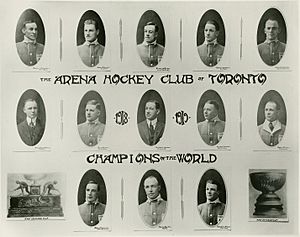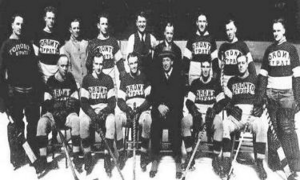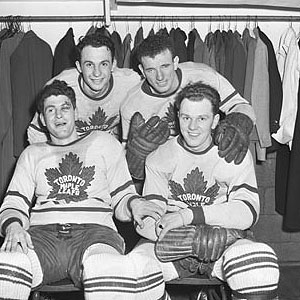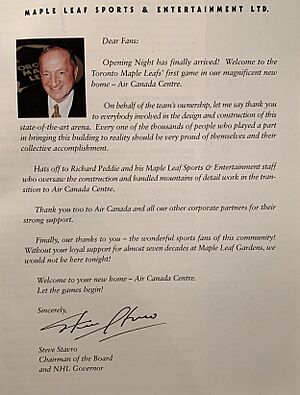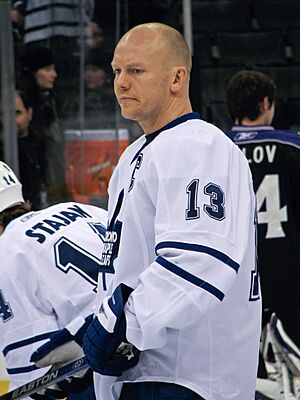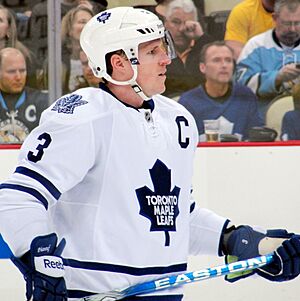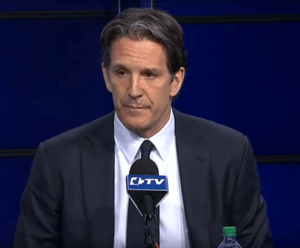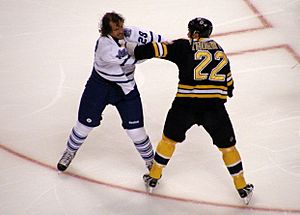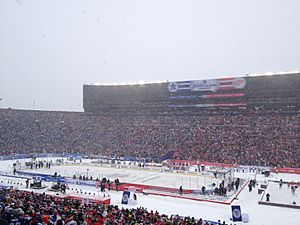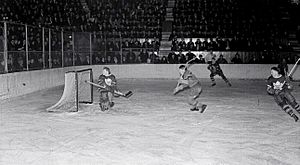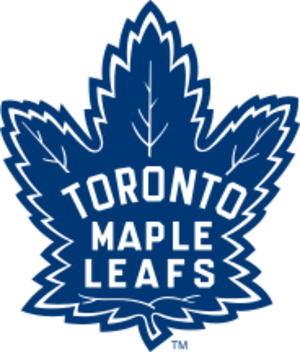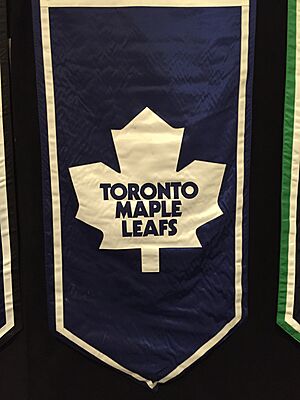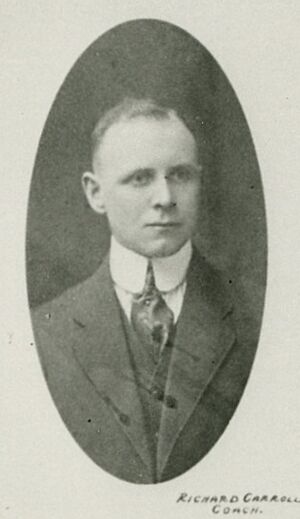Toronto Maple Leafs facts for kids
Quick facts for kids Toronto Maple Leafs |
|
|---|---|
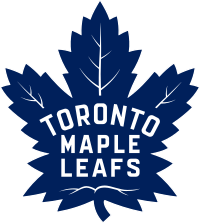 |
|
| Conference | Eastern |
| Division | Atlantic |
| Founded | 1917 |
| History | Toronto Arenas 1917–1919 Toronto St. Patricks 1919–1927 Toronto Maple Leafs 1927–present |
| Home arena | Scotiabank Arena |
| City | Toronto, Ontario |
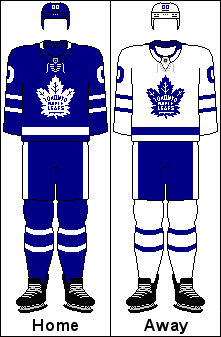 |
|
| Colours | Blue, white |
| Media | Sportsnet Ontario TSN4 Sportsnet 590 The Fan TSN Radio 1050 |
| Owner(s) | Maple Leaf Sports & Entertainment (Keith Pelley, president & CEO) |
| General manager | Brad Treliving |
| Head coach | Craig Berube |
| Captain | Auston Matthews |
| Minor league affiliates | Toronto Marlies (AHL) |
| Stanley Cups | 13 (1917–18, 1921–22, 1931–32, 1941–42, 1944–45, 1946–47, 1947–48, 1948–49, 1950–51, 1961–62, 1962–63, 1963–64, 1966–67) |
| Conference championships | 0 |
| Presidents' Trophies | 0 |
| Division championships | 7 (1932–33, 1933–34, 1934–35, 1937–38, 1999–2000, 2020–21, 2024–25) |
The Toronto Maple Leafs (often called the Leafs) are a professional ice hockey team from Toronto, Canada. They play in the National Hockey League (NHL) as part of the Atlantic Division in the Eastern Conference. The team is owned by Maple Leaf Sports & Entertainment, which also owns other sports teams in Toronto.
The club started as the Toronto Arenas in the first 1917–18 NHL season. Two years later, they changed their name to the Toronto St. Patricks. In 1927, Conn Smythe bought the team and renamed them the Maple Leafs. For their first 14 seasons, the team played at the Mutual Street Arena. In 1931, they moved to Maple Leaf Gardens. Since February 1999, the Maple Leafs have played at Scotiabank Arena, which was once called Air Canada Centre.
The Maple Leafs have won more Stanley Cup championships and played more NHL seasons than any team except the Montreal Canadiens. They had two amazing periods of success, called "dynasties," from 1946 to 1951 and from 1961 to 1967. During these times, they won eight Stanley Cups. However, they have not won a championship since 1967, which is the longest drought in league history at 57 seasons. The Maple Leafs have strong rivalries with the Boston Bruins, Buffalo Sabres, Detroit Red Wings, Montreal Canadiens, and Ottawa Senators. Their main minor league team is the Toronto Marlies in the American Hockey League (AHL).
Many people connected to the Maple Leafs have been honored in the Hockey Hall of Fame. The team has also retired the numbers of nineteen players, including the first retired number in all of professional sports.
Contents
- Team History: From Arenas to Maple Leafs
- Team Culture
- Team Operations
- Season Records
- Players and Team Staff
- Team and League Honors
- More Information
- See also
Team History: From Arenas to Maple Leafs
Early Years (1917–1927)
The National Hockey League (NHL) began in 1917 in Montreal. It was formed by teams from the old National Hockey Association (NHA) who had problems with Eddie Livingstone, the owner of the Toronto Blueshirts. The other team owners wanted to remove Livingstone. Since they couldn't vote him out, they created a new league, the NHL, and didn't invite him.
The NHL decided to have four teams: the Canadiens, Montreal Maroons, Ottawa, and one more from Quebec City or Toronto. Toronto joined the NHL on November 26, 1917, because of money worries with the Quebec team. The Arena Company, which owned the Arena Gardens, was given temporary rights to the Toronto team for the first season. They were told to fix their issues with Livingstone or give the team back to the league.
The team didn't have an official name but was called "the Blueshirts" or "the Torontos." Even though the first players were from the NHA's Toronto Blueshirts, the Maple Leafs don't claim the Blueshirts' history as their own. In their first season, the team made the first trade in NHL history. They sent Sammy Hebert to the Senators for cash. Led by manager Charlie Querrie and coach Dick Carroll, the team won the Stanley Cup in their very first season, 1917–18.
For the next season, the Arena Company formed the Toronto Arena Hockey Club. This club was given full NHL membership. The Arena Company also decided that only NHL teams could play at the Arena Gardens. This move effectively ended the NHA. Livingstone sued to get his players back. The legal costs forced the Arenas to sell some of their best players. This led to a terrible season in 1918–19, with only five wins. The team's winning percentage that season is still the worst in franchise history. The 1919 Stanley Cup Final was canceled due to a worldwide flu epidemic.
The legal problems caused the Arena Company to go bankrupt, and they had to sell the team. On December 9, 1919, Querrie helped sell the team to the owners of the St. Patricks Hockey Club. The new owners renamed the team the Toronto St. Patricks (or St. Pats). They changed the team colors from blue to green. The club won their second Stanley Cup in 1922. Babe Dye scored four goals in the 5–1 win against the Vancouver Millionaires to clinch the Cup.
In 1924, the team's ownership changed again. Movie theater owner Nathan Nathanson and mining leader Jack Bickell bought shares from the Hamblys. Bickell invested money in the St. Pats to help his friend Querrie reorganize the team's finances.
Conn Smythe's Influence (1927–1961)
After several tough financial seasons, the St. Patricks' owners thought about selling the team to C. C. Pyle, who wanted to move the team to Philadelphia. However, Toronto Varsity Blues coach Conn Smythe put together his own group. He offered less money but convinced the owners to accept his bid. He argued that local pride was more important than money. Bickell became the team president.
Smythe took control on February 14, 1927. He immediately renamed the team the Maple Leafs, after Canada's national symbol. The team had to finish the 1926–27 season as the St. Patricks. Smythe said he chose the maple leaf because of his experiences as a Canadian Army officer during World War I. He saw the maple leaf as a "badge of courage" and a reminder of home. The team was not the first to use the name; a Toronto baseball team had been called the "Toronto Maple Leafs" since 1895. Smythe became the main voice of the team for the next forty years.
At first, reports said the team's colors would be red and white. But the Leafs wore white jerseys with a green maple leaf for their first game on February 17, 1927. On September 27, 1927, the Leafs announced their colors would be blue and white. Smythe later said he chose blue for the Canadian skies and white for snow. These colors were also used on his gravel and sand business trucks. Blue was also a color historically linked to the City of Toronto.
Maple Leaf Gardens Opens (1930s)
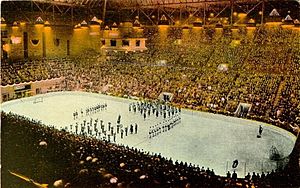
By 1930, Smythe realized they needed a new arena. He felt the Arena Gardens was old and lacked modern features. He found enough investors and bought land from the Eaton family. The new arena was built in just five months.
The Maple Leafs played their first game at their new arena, Maple Leaf Gardens, on November 12, 1931. They lost 2–1 to the Chicago Black Hawks. The opening ceremony included a performance by the 48th Highlanders of Canada Pipe and Drums. This military band still performs at home opening games. The game also featured Foster Hewitt in his new press box above the ice. He started his famous Hockey Night in Canada radio broadcasts from there.
In the 1931–32 NHL season, the Maple Leafs were led by the "Kid Line" of Busher Jackson, Joe Primeau, and Charlie Conacher. Coach Dick Irvin guided them to their third Stanley Cup that season. They beat the Chicago Black Hawks, the Montreal Maroons, and the New York Rangers. Smythe was especially happy to beat the Rangers. He had been the Rangers' first general manager and coach but was fired before their first season began.
Maple Leafs star forward Ace Bailey was badly injured in 1933 when Boston Bruins defenceman Eddie Shore hit him from behind. Leafs defenceman Red Horner knocked Shore out with a punch. Bailey's career ended due to the injury. The Leafs held the Ace Bailey Benefit Game, the NHL's first All-Star Game, to raise money for Bailey. His jersey number was retired that same night. The Leafs reached the finals five more times in the next seven years but lost each time. After the 1939–40 NHL season, Smythe let Irvin leave and replaced him with former Leafs captain Hap Day.
The First Dynasty (1940s)
In the 1942 Stanley Cup Final, the Maple Leafs were losing three games to none against Detroit. Fourth-line forward Don Metz inspired the team, scoring a hat-trick in game four and the winning goal in game five. Goalie Turk Broda shut out the Wings in game six. Sweeney Schriner scored two goals in the third period to win game seven 3–1. This completed a "reverse-sweep," meaning they won after being down 3–0. The Leafs are still the only team to do this in the Stanley Cup Final. Captain Syl Apps won the Lady Byng Memorial Trophy that season for his sportsmanship.
Smythe, who joined the Canadian Army during World War II, was allowed to watch the final game of the 1942 finals. He arrived in his military uniform. Earlier, Smythe had arranged for many Maple Leafs players to train with the Toronto Scottish Regiment. Many players, including Apps and Broda, enlisted and missed several seasons. During this time, the Leafs relied on new players like rookie goalie Frank McCool and defenceman Babe Pratt.
The Maple Leafs beat the Red Wings in the 1945 Stanley Cup Final. They won the first three games, with McCool getting two shutouts. But the Red Wings won the next three games, just like in 1942. The Leafs won game seven 2–1, preventing a full comeback by Detroit.
After the war, players returned to their teams. With Apps and Broda playing well, the Maple Leafs beat the Canadiens in the 1947 Stanley Cup Final. To make their center position stronger, the Leafs got Cy Thomas and Max Bentley. With these new players, the Leafs won their second straight Stanley Cup, sweeping the Red Wings in the 1948 Stanley Cup Final. After this win, the Leafs had won more Stanley Cups than Montreal. Apps retired after the 1948 finals, and Ted Kennedy became captain. Under Kennedy, the Leafs reached the 1949 Stanley Cup Final and swept the Red Wings again, winning their third straight Cup. The Red Wings finally ended their losing streak against the Leafs in the 1950 playoffs.
The Barilko Story (1950s)
The Maple Leafs and Canadiens met again in the 1951 Stanley Cup Final. Five games in the series went into overtime. Defenceman Bill Barilko scored the winning goal in overtime, even though coach Joe Primeau told him to stay back. Barilko helped the team win its fourth Stanley Cup in five years. Sadly, he disappeared in a plane crash four months later. The crash site was not found for 11 years. The Leafs didn't win another Cup in the 1950s. Some people thought the team was "cursed" and wouldn't win until Barilko's body was found. The "curse" ended after the Leafs won the 1962 Stanley Cup, which happened six weeks before Barilko's plane was discovered.
After their 1951 victory, the team didn't play as well. They finished third in the 1951–52 NHL season and were swept by the Red Wings in the semifinals. In the 1952–53 NHL season, the Leafs missed the playoffs for the first time since 1946. The team's struggles were partly because their junior player development system wasn't producing good players. It wasn't until later in the decade that the Leafs' feeder clubs started producing talented players again.
After two years out of the playoffs, the Maple Leafs made it back in the 1958–59 NHL season. Under Punch Imlach, their new general manager and coach, the Leafs reached the 1959 Stanley Cup Final, losing to the Canadiens. Building on this success, the Leafs finished second in the 1959–60 NHL season. They reached their second straight Cup Final but were again defeated by the Canadiens.
New Owners and Another Dynasty (1961–1971)
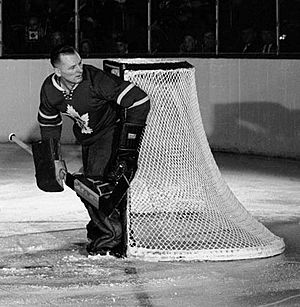
In the 1960s, the Leafs became a stronger team. They had Johnny Bower as goalie, and Bob Baun, Carl Brewer, Tim Horton, and Allan Stanley as defencemen. To improve their forwards, Imlach traded for Red Kelly in 1960. Kelly, originally a defenceman, became a center and helped players like Frank Mahovlich and captain George Armstrong. Rookies Bob Nevin and Dave Keon also joined the team. Despite these additions, the Leafs lost in the 1961 playoffs due to injuries.
In November 1961, Smythe sold most of his shares in the team's parent company, Maple Leaf Gardens Limited (MLGL). He sold them to a group including his son Stafford Smythe, newspaper owner John W. H. Bassett, and Toronto Marlboros president Harold Ballard. Smythe received a good retirement salary. He sold his remaining shares and left the board in March 1966.
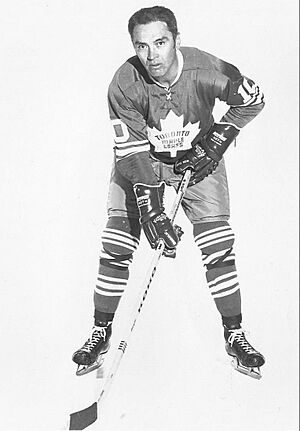
Under the new owners, Toronto won three more Stanley Cups in a row. They won the 1962 Stanley Cup Final by beating the Chicago Black Hawks. In the 1962–63 NHL season, the Leafs finished first in the league for the first time since 1948. They won their second Stanley Cup of the decade in the playoffs. The 1963–64 NHL season saw some player changes. Imlach traded Duff and Nevin for Andy Bathgate and Don McKenney to boost the team. The Leafs made the playoffs and the Cup Final. In game six of the 1964 Cup Final, Baun broke his ankle but returned to play with it frozen. He scored the winning goal in overtime against the Red Wings. The Leafs won their third straight Stanley Cup with a 4–0 victory in game seven.
In the two seasons after these Cup wins, several players left, and new ones joined, like Marcel Pronovost and Terry Sawchuk. During the 1966–67 NHL season, the team lost 10 games in a row, sending Imlach to the hospital. But when King Clancy took over as coach, the team went on a 10-game undefeated streak. The Leafs reached their last Cup Final in 1967. They played against Montreal, who were the favorites. The Leafs won, with Bob Pulford scoring in double-overtime in game three, and Jim Pappin scoring the series winner in game six. Keon was named the playoff's most valuable player.
From 1968 to 1970, the Maple Leafs only made the playoffs once. They lost players in the 1967 NHL expansion draft. Imlach's strict style and his opposition to players joining the new Players' Association caused problems. He was also criticized for being too loyal to older players. In the 1967–68 NHL season, Mahovlich was traded to Detroit for Paul Henderson and Norm Ullman. The Leafs returned to the playoffs in the 1968–69 NHL season but were swept by the Bruins. Stafford Smythe then fired Imlach.
The Maple Leafs missed the playoffs in the 1969–70 NHL season. Their low finish allowed them to draft Darryl Sittler in the 1970 NHL amateur draft. The Leafs returned to the playoffs in the 1970–71 NHL season with Sittler, and new goalies Bernie Parent and Jacques Plante. They lost in the first round to the Rangers.
The Ballard Years (1971–1990)
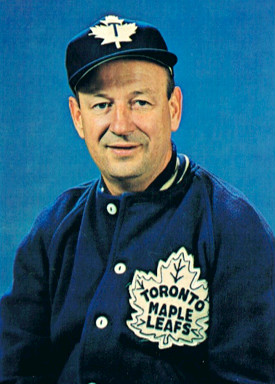
In 1971, Harold Ballard became the main owner of the Maple Leafs. After disagreements, Bassett sold his shares to Ballard and Stafford Smythe. Stafford Smythe died in October 1971. Ballard then bought all of Stafford's shares in February 1972. Six months later, Ballard faced legal issues and was unable to manage the team for a period.
By the end of 1971, the World Hockey Association (WHA) started as a rival to the NHL. Ballard thought the WHA wouldn't last, which caused the Maple Leafs to lose key players like Parent to the new league. The Leafs finished with one of the worst records in the 1972–73 NHL season. They drafted Lanny McDonald with the fourth pick in the 1973 NHL amateur draft. General Manager Jim Gregory also acquired other high draft picks and got Borje Salming.
Despite adding players like Tiger Williams and coach Roger Neilson, the Maple Leafs were often eliminated in the playoffs by stronger Flyers or Canadiens teams from 1975 to 1979. Neilson was popular but disagreed with Ballard, who fired him in 1978. Neilson was brought back after players and fans protested. He coached until after the 1979 playoffs, when he was fired again, along with Gregory. Imlach replaced Gregory as general manager.
In his second time as general manager, Imlach argued with Leafs captain Darryl Sittler. To weaken Sittler's influence, Imlach traded McDonald, who was Sittler's friend. By the end of the 1979–80 NHL season, Imlach had traded almost half the team. As the situation worsened, Sittler asked to be traded. The new general manager, Gerry McNamara, traded Sittler in January 1982. Rick Vaive became the new captain.
The Maple Leafs' management continued to change often in the 1980s. The team didn't have much success, missing the playoffs in 1982, 1984, and 1985. However, in those days, the top four teams in each division made the playoffs, no matter their record. This meant the Leafs sometimes made the playoffs with very low winning percentages.
The low finishes allowed the team to draft Wendel Clark first overall in the 1985 NHL entry draft. Clark helped lead the Leafs to the playoffs from 1986 to 1988, and again in 1990. Harold Ballard died on April 11, 1990.
A New Era and Success (1990–2004)
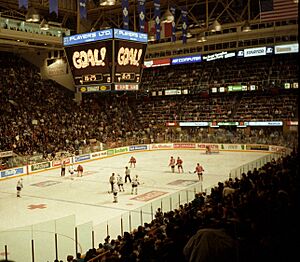
Don Crump, Don Giffin, and Steve Stavro managed Ballard's estate. Stavro became chairman of Maple Leaf Gardens Ltd. and governor of the Maple Leafs. Cliff Fletcher was hired as the new general manager.
The new owners allowed Fletcher to manage hockey operations without too much interference, unlike Ballard. Fletcher quickly built a strong team. He hired Pat Burns as coach and made trades for players like Doug Gilmour and Dave Andreychuk. With great goaltending from Felix Potvin, the team set a franchise record of 99 points.
In the 1993 playoffs, Toronto beat the Detroit Red Wings and the St. Louis Blues in seven games each. The Leafs then faced the Los Angeles Kings in the conference finals. They led the series 3–2 but lost game six. The game was controversial because Wayne Gretzky hit Gilmour with his stick, but no penalty was called. Gretzky scored the winning goal moments later. The Leafs lost game seven 5–4.
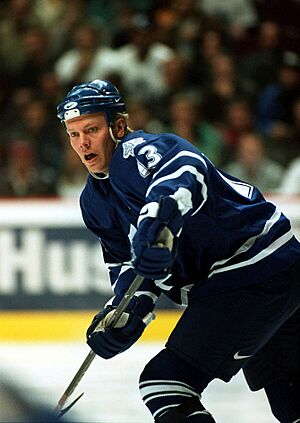
The Leafs had another strong season in 1993–94, starting with ten straight wins and finishing with 98 points. They reached the conference finals again but lost to the Vancouver Canucks. In the 1994 NHL entry draft, the Leafs traded Wendel Clark to the Quebec Nordiques and got Mats Sundin. After Gilmour was traded in 1997, Sundin became captain. The Leafs missed the playoffs in 1997 and 1998, and Fletcher was replaced as general manager.
New Home, New Millennium (1998–2004)
On February 12, 1998, MLGL bought the Toronto Raptors, a basketball team, and their new arena from Allan Slaight and Scotiabank. MLGL was renamed Maple Leaf Sports & Entertainment (MLSE), becoming the parent company for both teams.
Curtis Joseph became the team's starting goalie, and Pat Quinn was hired as head coach before the 1998–99 NHL season. In 1998, the NHL changed its conferences, and the Leafs moved to the Eastern Conference. On February 13, 1999, the Leafs played their last game at the Gardens before moving to their new home, the Air Canada Centre. In the 1999 Stanley Cup playoffs, the team reached the conference finals but lost to the Buffalo Sabres.
In the 1999–2000 NHL season, the Leafs hosted the 2000 National Hockey League All-Star Game. They had their first 100-point season and won their first division title in 37 years. In both the 2000 and 2001 playoffs, the Leafs beat the Ottawa Senators in the first round but lost to the New Jersey Devils in the second round. In the 2002 playoffs, the Leafs beat the Islanders and Senators. However, they lost to the Carolina Hurricanes in the conference finals. The 2001–02 season was impressive because many key players were injured, but depth players like Alyn McCauley, Gary Roberts, and Darcy Tucker stepped up.
Joseph left as a free agent in 2002, so the Leafs signed Ed Belfour as their new starting goalie. Belfour played well in the 2002–03 NHL season. The Leafs lost to Philadelphia in the first round of the 2003 Stanley Cup playoffs. In 2003, the Ontario Teachers' Pension Plan (OTPP) bought most of MLSE, and Stavro resigned. Quinn remained coach but was replaced as general manager by John Ferguson Jr..
Before the 2003–04 NHL season, the team trained in Sweden and played in the NHL Challenge. The Leafs had a very successful regular season, leading the NHL at the All-Star Game. They finished with a franchise-record 103 points. In the 2004 Stanley Cup playoffs, the Leafs beat the Senators in the first round for the fourth time in five years. But they lost to the Flyers in the second round.
After the Lockout (2005–2014)
After the 2004–05 NHL lockout, the Maple Leafs had their longest playoff drought. They struggled in the 2005–06 NHL season, missing the playoffs for the first time since 1998. Quinn was later fired as head coach.
Paul Maurice, who coached the Maple Leafs' farm team, the Toronto Marlies, became the new head coach. Despite coaching changes and roster changes, the team missed the playoffs in 2006–07. In the 2007–08 NHL season, John Ferguson Jr. was fired and replaced by Cliff Fletcher temporarily. The Leafs missed the playoffs again, making it three seasons in a row for the first time since 1928. This was also Sundin's last year with the Leafs. On May 7, 2008, Maurice was fired, and Ron Wilson became the new head coach.
On November 29, 2008, the Maple Leafs hired Brian Burke as their new general manager. On June 26, 2009, Burke drafted Nazem Kadri with the seventh overall pick. On September 18, 2009, Burke traded draft picks to the Boston Bruins for forward Phil Kessel. On January 31, 2010, the Leafs traded with the Calgary Flames to get defenceman Dion Phaneuf. In June, Phaneuf was named captain after two seasons without one. On February 18, 2011, the team traded Tomas Kaberle to the Bruins.
On March 2, 2012, Burke fired Wilson and named Randy Carlyle the new head coach. However, Wilson had just received a contract extension. In August 2012, the OTPP sold their shares in MLSE to BCE Inc. and Rogers Communications. On January 9, 2013, Burke was fired and replaced by Dave Nonis. In their first full season under Carlyle, Toronto made the playoffs in the 2012–13 NHL season for the first time in eight years. However, the Leafs lost in seven games to Boston in the first round. The team did not make the playoffs in the 2013–14 NHL season.
Brendan Shanahan Era (2014–2025)
After the 2013–14 season, Brendan Shanahan became the president and an alternate governor of the Maple Leafs. On January 6, 2015, the Leafs fired Randy Carlyle as head coach. The team then had a record of 11 consecutive games without a win. In February, Shanahan got approval to completely rebuild the team. Dave Nonis and Peter Horachek were fired on April 12. Several assistant coaches and scouts were also let go.
On May 20, 2015, Mike Babcock was named the new head coach. On July 23, Lou Lamoriello became the general manager. On July 1, 2015, the Leafs traded Kessel to the Pittsburgh Penguins. On February 9, 2016, the Leafs traded Phaneuf to the Ottawa Senators. The team finished last in the NHL for the first time since 1985. They won the draft lottery and used the first overall pick to draft Auston Matthews.
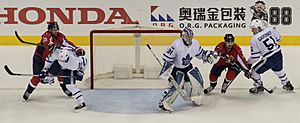
In their second season under Babcock, Toronto earned a wildcard spot for the 2017 Stanley Cup playoffs. On April 23, 2017, the Maple Leafs were eliminated by the top-seeded Washington Capitals.
Toronto finished the 2017–18 NHL season with a franchise-record 105 points. They faced the Boston Bruins in the first round and lost in seven games. Lamoriello's contract as general manager was not renewed. Kyle Dubas became the new general manager in May 2018. In the 2018 off-season, the Maple Leafs signed John Tavares. On April 1, the Maple Leafs made the 2019 Stanley Cup playoffs. They were eliminated in the first round by the Bruins again.
On October 2, 2019, Tavares was named the team's 25th captain. After a slow start to the 2019–20 NHL season, Babcock was fired on November 20, and Sheldon Keefe became the new head coach. The Maple Leafs were eliminated in the 2020 Stanley Cup Qualifiers by the Columbus Blue Jackets.
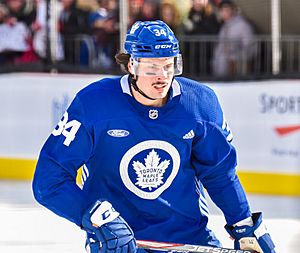
Due to the COVID-19 pandemic, the Leafs temporarily moved to the North Division for the 2020–21 season. They only played against other Canadian teams. On May 8, 2021, the Leafs won the North Division title. Matthews led the league in goals with 41, becoming the first Maple Leaf to win the Maurice "Rocket" Richard Trophy. However, the Leafs lost in the first round to their rivals, the Montreal Canadiens, after losing a 3–1 series lead.
The Leafs had another strong regular season in 2021–22, breaking their franchise record for points with 115 and wins with 50. Matthews became the first Leaf in a decade to score 60 goals and won the Hart Memorial Trophy. The Leafs made the playoffs but lost in the first round to the Tampa Bay Lightning in seven games. This loss made the Maple Leafs the first team in the four major North American sports leagues to lose five straight winner-take-all games.
In the 2022 off-season, goalies Jack Campbell and Petr Mrazek left the team. The Leafs acquired Matt Murray and signed Ilya Samsonov.
During the 2022–23 NHL season, the Leafs again played well, finishing with 111 points. However, the Boston Bruins had a record-setting season and finished first in the division. In the first round of the playoffs, the Leafs defeated the Lightning in six games. This was the first time the Maple Leafs advanced to the second round since 2004. They also became the first NHL team to win three road playoff games in overtime. However, the Leafs lost to the Florida Panthers in the second round. After the loss, Dubas' contract as general manager was not renewed. Brad Treliving replaced him on May 31.
In 2023–24, the team finished with 102 points. Matthews broke his own records for goals in a season with 69 and won his third Rocket Richard Trophy. However, they were eliminated in the first round of the playoffs by the Bruins again. After the season, Keefe was fired on May 9, and Craig Berube was hired as his replacement on May 17. On August 14, 2024, Tavares gave up his captain role to Matthews, who became the first American-born captain in team history.
The team finished the 2024–25 NHL season with 108 points, winning their first Atlantic Division championship. This set up a Battle of Ontario playoff series with the Ottawa Senators. Berube broke the record for most wins by a Maple Leafs coach in his first season. The Leafs defeated the Senators in six games. They then faced the Florida Panthers in the second round. Goaltender Anthony Stolarz was injured in game one and replaced by Joseph Woll. Toronto lost the series to Florida in seven games.
Shortly after the 2025 playoffs ended, it was announced that Shanahan would not return as team president.
Team Culture
Fan Base
Tickets for Maple Leafs home games are the most expensive in the NHL. Scotiabank Arena has 18,819 seats for Leafs games, with most reserved for season ticket holders. There is a long waiting list for season tickets. In a 2014 survey, the Leafs were ranked last among 122 professional teams in major North American sports leagues. They were especially low in ticket affordability.
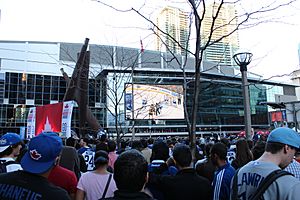
Leafs fans are known for their strong support and loyalty, even when the team struggles. They are thought to have the largest fan base in the NHL. A 2017 study found that the Leafs were one of only two NHL teams to always sell out their arena despite having a below-average winning percentage. On the other hand, fans of other teams often dislike the Leafs. In 2002, Sports Illustrated called the Leafs the "Most Hated Team in Hockey."
Despite their loyalty, fans have shown their unhappiness. In the 2011–12 NHL season, fans chanted for the coach and later the general manager to be fired. In the 2014–15 season, fans threw Leafs jerseys onto the ice to show their disapproval of the team's poor performance. During the 2015–16 NHL season, fans sometimes chanted "Let's go Blue Jays!" to show they were focusing on the more successful baseball team.
Many Leafs fans live throughout Ontario, Quebec, and even in New York state and Michigan. Because of this, away games in Montreal, Ottawa, Buffalo, and Detroit often have many Leafs fans. The Leafs are also popular in Atlantic Canada.
Rivalries
During the 25 years of the Original Six era (1942–67), teams played each other often, leading to intense rivalries. The Maple Leafs developed rivalries with the Boston Bruins, Detroit Red Wings, and Montreal Canadiens. They also have rivalries with the Ottawa Senators and a smaller one with the Buffalo Sabres, called the Battle of the QEW.
Boston Bruins
Both teams are Original Six teams. Their first game was on December 3, 1924, when the Toronto St. Patricks beat the Bruins 5–3. The Maple Leafs played their first playoff series against the Bruins in 1933, winning 3–2. From 1933 to 2019, they played 16 playoff series, including one Stanley Cup Final.
The rivalry became strong again in the 2013 Stanley Cup playoffs. The Bruins came back from a 4–1 deficit in the third period to beat the Maple Leafs in overtime. In the 2018, 2019, and 2024 Stanley Cup playoffs, the Bruins defeated the Maple Leafs in seven games each time.
Buffalo Sabres
The rivalry between the Buffalo Sabres and Toronto Maple Leafs exists because their home arenas are only about 160 kilometers (100 miles) apart. From 1970 to 2016, the Sabres won most of their home games against the Maple Leafs, even with many Toronto fans attending. Since the 1998–99 NHL season, both teams have been in the same division. Buffalo won the 1999 Eastern Conference finals against Toronto, which was their only playoff series. Because many Leafs fans live near Buffalo and tickets are cheaper there, Maple Leafs–Sabres games in Buffalo often have a large number of Leafs fans.
Detroit Red Wings
The Detroit Red Wings and the Maple Leafs are both Original Six teams. They played their first game in 1927. From 1929 to 1993, the teams met in 16 playoff series and seven Stanley Cup Final. They have played each other in more playoff series than any other two teams in NHL history, except for the Bruins and Canadiens. Many fans in areas like Windsor, Ontario, support both teams, adding to the rivalry.
The rivalry was strongest during the Original Six era. The Leafs and Red Wings met in the playoffs six times in the 1940s, including four Stanley Cup Finals. The Leafs won five of those six meetings. In the 1950s, they met in six Stanley Cup semifinals, with the Red Wings winning five. From 1961 to 1967, they met in three playoff series, including two Stanley Cup Finals. In total, over 25 years, they played 15 playoff series, and the Maple Leafs won all six Cup Finals.
The teams have only met three times in the playoffs since the Original Six era, with their last meeting in 1993. When the Leafs moved to the Eastern Conference in 1998, they played each other less often. The rivalry became intradivisional again in 2013 when Detroit moved to the Atlantic Division. Many Leafs fans live near Detroit, so Maple Leafs–Red Wings games in Detroit often have at least 40 percent Leafs fans.
Montreal Canadiens
The rivalry between the Montreal Canadiens and the Maple Leafs is the oldest in the NHL. Both clubs have been active since the first NHL season in 1917. In the early 20th century, the rivalry represented a larger cultural difference between English and French Canada. The Canadiens have won 24 Stanley Cups, and the Maple Leafs have won 13.
The rivalry was at its peak in the 1960s, when the Canadiens and Leafs won almost every Cup. The two clubs had 15 playoff meetings. However, the rivalry has lessened since they didn't meet in the postseason from 1979 to 2021. It also suffered when they were placed in different conferences in 1981. The rivalry became intradivisional again in 1998 when the Leafs moved to the Northeast Division.
The rivalry's cultural impact can be seen in books and art. The story The Hockey Sweater by Roch Carrier shows the rivalry from a Canadiens fan's view. It talks about a mother making her son wear a Maple Leafs sweater. This rivalry is also shown at Toronto's College subway station. It has murals of the two teams on different platforms. Many Leafs fans live near Montreal, so games at the Bell Centre often have many Leafs fans.
Ottawa Senators
The modern Ottawa Senators joined the NHL in 1992. The rivalry between the two teams started in the late 1990s. From 1992 to 1998, Ottawa and Toronto were in different conferences, so they rarely played. However, before the 1998–99 NHL season, the teams were put in the same division. From 2000 to 2004, they played four playoff series, and the Leafs won all of them. Many Leafs fans live near Ottawa, so games at the Canadian Tire Centre often have at least 70 percent Leafs fans.
Team Operations
Branding
Logo and Uniform
The team is known by its maple leaf logo on the uniform. The Maple Leafs' jersey has a long history and is very popular. The team's uniforms have changed several times. The first uniforms were blue with a letter T. In 1919, when the team became the St. Patricks, the uniforms were green with "Toronto St. Pats" on them.
When the team was renamed the Maple Leafs in 1927, the logo changed, and the team went back to blue uniforms. The logo was a 48-point maple leaf with white letters. The home jersey was blue with stripes. The road uniform was white with stripes. In 1937, veins were added to the leaf. In 1942, a 35-point leaf was introduced. In 1946, the logo got a border, and "C" for captain and "A" for alternate captain appeared on the jerseys. In 1958, laces were added to the neck. In 1961, player numbers were added to the sleeves.
The fourth big change came in the 1966–67 season. The logo became an 11-point leaf, like the new flag of Canada, to celebrate Canada's 100th birthday. The new logo had a simpler font. The stripes on the sleeves and waist also changed. Before the 1970–71 season, the Leafs adopted a new 11-point leaf logo with "Toronto" written straight across. Other changes included new sleeve designs and a single stripe at the waist. In 1977, NHL rules required names on the back of uniforms. Harold Ballard resisted this, but eventually, the team added names in contrasting colors.
For the NHL's 75th anniversary in 1991–92, the Leafs wore "Original Six" style uniforms from the 1940s. Fans liked them, so the Leafs changed their uniforms for the 1992–93 NHL season. The new uniforms had two stripes on the sleeves and waist, with the 1970 11-point leaf logo. A vintage leaf crest was on the shoulders. These uniforms were changed a few times over the years.
In 1997, Nike made the Maple Leafs uniforms. They added a wishbone collar and changed the player name and number font. CCM took over in 1999 and kept most of the changes. In 2000, the numbers were changed to block numbers with silver outlines. The Leafs also started wearing a white 1960s-style throwback jersey.
When Reebok took over NHL jersey contracts in 2007, the uniforms changed again. The TML monograms were removed from the shoulders, and silver outlines on numbers were replaced. In 2010, waistline stripes were brought back, and the vintage leaf returned to the shoulders. The Leafs also brought back the 1967–1970 blue uniform as their third uniform. For the 2014 NHL Winter Classic, the Leafs wore a jersey inspired by their 1930s uniforms.
On February 2, 2016, the team showed a new logo for its 100th anniversary season. It went back to an older style, with 31 points to remember the 1931 opening of Maple Leaf Gardens, and 17 veins for its start in 1917. 13 veins are at the top to honor their 13 Stanley Cup wins. New uniforms were also revealed, with a custom font for names and numbers.
The Maple Leafs have worn special throwback uniforms, like those inspired by the Toronto Arenas or St. Pats. They also use modern "historically inspired" uniforms. For the Centennial Classic, players wore blue jerseys with white stripes, honoring the St. Pats. For the 2020–21 season, they wore "reverse retro" uniforms with silver stripes and an older logo. For the 2022 Heritage Classic, they wore a modified Arenas throwback. A second "reverse retro" uniform was released, based on their 1962 road uniforms.
Other alternate uniforms include a white one with blue stripes for the 2018 NHL Stadium Series. These were mostly white to honor the Royal Canadian Navy.
During the 2021–22 season, the Leafs partnered with TikTok for helmet advertising. In 2022–23, they partnered with the Dairy Farmers of Ontario, showing their "Milk" logo. For 2023–24, Pizza Pizza was the helmet partner for home games. In 2024–25, Mondelez's Oreo was the helmet partner for all games.
On March 22, 2022, the Maple Leafs showed a new alternate uniform with black as the main color and blue as a trim. This "Next Gen" uniform has a tie-dye background and a skyline design. It also has a reversible crest with Canadian singer Justin Bieber's logo inside a yellow Maple Leafs logo.
Mascot
The Maple Leafs' mascot is Carlton the Bear. He is a polar bear whose name and number (#60) come from the location of Maple Leaf Gardens at 60 Carlton Street. Carlton first appeared on July 29, 1995.
Broadcasting
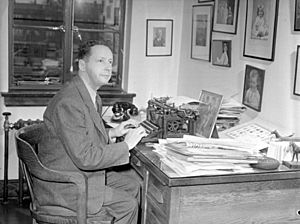
Because Bell Canada and Rogers Communications own parts of MLSE, Maple Leafs games are broadcast by both companies. Regional TV broadcasts are on Rogers' Sportsnet Ontario and Bell's TSN4. Mike Johnson provides commentary for Bell's broadcasts, and Gord Miller does play-by-play. For Rogers, Craig Simpson does commentary, and Chris Cuthbert does play-by-play.
Radio broadcasts are also split between Rogers' CJCL (Sportsnet 590, The Fan) and Bell's CHUM (TSN Radio 1050). Both radio broadcasts have Jim Ralph for commentary and Joe Bowen for play-by-play.
Radio broadcasts of games started in 1923. The first Leafs hockey game on TV was on November 10, 1952. This was also the first English-language NHL game televised in Canada. Foster Hewitt was the Leafs' first play-by-play radio announcer from 1927 to 1978. He also did TV play-by-play from 1952 to 1958.
Home Arenas and Practice Facilities
| Arena | Tenure |
|---|---|
| Arena Gardens | 1917–1931 |
| Maple Leaf Gardens | 1931–1999 |
| Scotiabank Arena | 1999–present |
The team's first home was the Arena Gardens, also known as the Mutual Street Arena. It was Toronto's main ice hockey venue from 1912 to 1931. The Arena Gardens was one of the first arenas in Canada with artificial ice. The Arena was torn down in 1989, and much of the land became homes. In 2011, part of the site became a city park.

In 1931, Conn Smythe built Maple Leaf Gardens for C$1.5 million. The arena quickly became known as the "Carlton Street Cashbox" because games were always sold out. The Maple Leafs won 11 Stanley Cups while playing at the Gardens. The first annual NHL All-Star Game was held there in 1947. The Gardens opened on November 12, 1931, with the Maple Leafs losing 2–1. On February 13, 1999, the Maple Leafs played their last game there, also losing to the Blackhawks. The building is now a multi-purpose facility with a grocery store, other shops, and an athletics arena for Toronto Metropolitan University.
The Maple Leafs currently use two facilities in Toronto. They moved from the Gardens on February 20, 1999, to their current home, Air Canada Centre, now called Scotiabank Arena. This arena is in downtown Toronto and is owned by MLSE. It is also home to the NBA's Toronto Raptors and the National Lacrosse League's Toronto Rock. The Maple Leafs also practice at the Ford Performance Centre. This facility opened in 2009 and has three NHL rinks and one Olympic-sized rink.
On January 1, 2017, the Maple Leafs played an outdoor home game against the Detroit Red Wings at BMO Field. This outdoor game was called the NHL Centennial Classic and celebrated the team's and NHL's 100th seasons.
Minor League Teams
The Maple Leafs are connected with the Toronto Marlies of the American Hockey League. The Marlies play at Coca-Cola Coliseum in Toronto. The Maple Leafs' parent company has owned the Marlies since 1978.
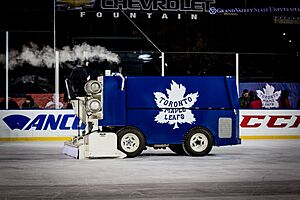
The first AHL team owned by the Maple Leafs was the Rochester Americans. The Leafs owned them with the Montreal Canadiens from 1956 to 1959. The Leafs then owned them alone until 1966. They continued as their minor league team until 1969. The Leafs didn't have an AHL team from 1969 to 1978. After some struggles, MLGL decided to restart their own farm system. They helped create the Marlies franchise in 1978. The Marlies were first called the New Brunswick Hawks and moved several times before coming to Toronto in 2005.
The Newfoundland Growlers were the ECHL affiliate of the Maple Leafs from 2018 until 2024. They played in St. John's, Newfoundland. The Growlers were not owned by MLSE. The Growlers stopped playing in 2024. The Cincinnati Cyclones became the ECHL affiliate of the Maple Leafs in July 2024.
The Marlies were named after the Toronto Marlboros, a junior hockey team. The Marlboros were sponsored by the Leafs from 1927 to 1989. The Marlboros were one of two junior hockey teams the Leafs sponsored. These junior teams helped develop young players for the Leafs.
Ownership
The Maple Leafs are one of six professional sports teams owned by Maple Leaf Sports & Entertainment (MLSE). In 2024, Forbes estimated the team's value at US$3.8 billion, making them the most valuable team in the NHL.
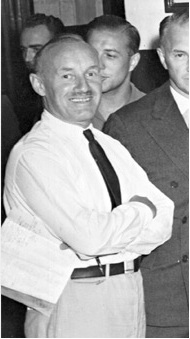
The team was first owned by the Arena Gardens of Toronto, Limited. The club became a permanent NHL team after its first season. Charles Querrie and Hubert Vearncombe were its owners. The Arena Company owned the club until 1919, when legal issues forced them into bankruptcy. Querrie then helped sell the Arena Garden's share to the owners of the St. Patricks Hockey Club. Querrie led the new ownership group until 1927, when the club was for sale. Conn Smythe bought the team for $160,000. In 1929, Smythe decided the Maple Leafs needed a new arena. To pay for it, Smythe started Maple Leaf Gardens Limited (MLGL), a public company that owned both the Maple Leafs and the new arena.
Smythe was the public face of MLGL, but he didn't fully control the company until 1947. Smythe remained the main owner until 1961. He then sold most of his shares to a group including Harold Ballard, John W. H. Bassett, and Stafford Smythe. Ballard became the majority owner in February 1972 after Stafford Smythe died. Ballard was the main owner of MLGL until he died in 1990. The company remained public until 1998, when a group led by Steve Stavro bought enough stock to make it a private company.
MLGL started as a hockey company, owning parts of junior hockey clubs. Later, it owned the Hamilton Tiger-Cats football team for a while. On February 12, 1998, MLGL bought the Toronto Raptors basketball team and their new arena. After this, MLGL changed its name to MLSE. MLSE now also owns the Toronto FC soccer team, the Toronto Marlies hockey team, the Toronto Argonauts football team, and part of Maple Leaf Square.
The current ownership structure began in 2012. The Ontario Teachers' Pension Plan sold its 75 percent share in MLSE to BCE Inc. and Rogers Communications. This deal was worth $1.32 billion. Rogers and Bell jointly control their 75 percent interest. Larry Tanenbaum owns the remaining 25 percent and is the chairman of MLSE.
| Ownership structure of Maple Leafs Sports & Entertainment | |||||||||||||||||||||||||||||||||||||||||||||||||||||||||||||||||||||||||||||||||||||||||||||||||||||||||||||||||||||||||||||||||||||||||||||||||||||||||||||||||||||||||||||||||||||||||||||
|---|---|---|---|---|---|---|---|---|---|---|---|---|---|---|---|---|---|---|---|---|---|---|---|---|---|---|---|---|---|---|---|---|---|---|---|---|---|---|---|---|---|---|---|---|---|---|---|---|---|---|---|---|---|---|---|---|---|---|---|---|---|---|---|---|---|---|---|---|---|---|---|---|---|---|---|---|---|---|---|---|---|---|---|---|---|---|---|---|---|---|---|---|---|---|---|---|---|---|---|---|---|---|---|---|---|---|---|---|---|---|---|---|---|---|---|---|---|---|---|---|---|---|---|---|---|---|---|---|---|---|---|---|---|---|---|---|---|---|---|---|---|---|---|---|---|---|---|---|---|---|---|---|---|---|---|---|---|---|---|---|---|---|---|---|---|---|---|---|---|---|---|---|---|---|---|---|---|---|---|---|---|---|---|---|---|---|---|---|---|
|
|||||||||||||||||||||||||||||||||||||||||||||||||||||||||||||||||||||||||||||||||||||||||||||||||||||||||||||||||||||||||||||||||||||||||||||||||||||||||||||||||||||||||||||||||||||||||||||
Season Records
This is a partial list of the last five seasons completed by the Maple Leafs. For the full season-by-season history, see List of Toronto Maple Leafs seasons
Note: GP = Games played, W = Wins, L = Losses, OTL = Overtime Losses, Pts = Points, GF = Goals for, GA = Goals against
| Season | GP | W | L | OTL | Pts | GF | GA | Finish | Playoffs |
|---|---|---|---|---|---|---|---|---|---|
| 2020–21 | 56 | 35 | 14 | 7 | 77 | 187 | 148 | 1st, North | Lost in first round, 3–4 (Canadiens) |
| 2021–22 | 82 | 54 | 21 | 7 | 115 | 315 | 253 | 2nd, Atlantic | Lost in first round, 3–4 (Lightning) |
| 2022–23 | 82 | 50 | 21 | 11 | 111 | 279 | 222 | 2nd, Atlantic | Lost in second round, 1–4 (Panthers) |
| 2023–24 | 82 | 46 | 26 | 10 | 102 | 303 | 263 | 3rd, Atlantic | Lost in first round, 3–4 (Bruins) |
| 2024–25 | 82 | 52 | 26 | 4 | 108 | 268 | 231 | 1st, Atlantic | Lost in second round, 3–4 (Panthers) |
Players and Team Staff
Current Roster
Updated January 3, 2023
| # | Nat | Player | Pos | S/G | Age | Acquired | Birthplace |
|---|---|---|---|---|---|---|---|
| 12 | Zach Aston-Reese | LW | L | 31 | 2022 | Staten Island, New York | |
| 18 | Jordie Benn | D | L | 38 | 2022 | Victoria, British Columbia | |
| 78 | T. J. Brodie | D | L | 35 | 2020 | Chatham, Ontario | |
| 58 | Michael Bunting | LW | L | 30 | 2021 | Scarborough, Ontario | |
| 48 | Carl Dahlstrom |
D | L | 30 | 2021 | Stockholm, Sweden | |
| 47 | Pierre Engvall | LW | L | 29 | 2014 | Ljungby, Sweden | |
| 55 | Mark Giordano | D | L | 42 | 2022 | Toronto, Ontario | |
| 3 | Justin Holl | D | R | 33 | 2016 | Tonka Bay, Minnesota | |
| 29 | Pontus Holmberg | C | L | 26 | 2018 | Västerås, Sweden | |
| 20 | Dryden Hunt | LW | L | 30 | 2022 | Cranbrook, British Columbia | |
| 19 | Calle Jarnkrok | RW | R | 34 | 2022 | Gävle, Sweden | |
| 64 | David Kampf | C | L | 30 | 2021 | Jirkov, Czech Republic | |
| 15 | Alexander Kerfoot | C | L | 31 | 2019 | Vancouver, British Columbia | |
| 37 | Timothy Liljegren | D | R | 26 | 2017 | Kristianstad, Sweden | |
| 16 | Mitch Marner (A) | RW | R | 28 | 2015 | Markham, Ontario | |
| 34 | Auston Matthews (A) | C | L | 28 | 2016 | San Ramon, California | |
| 98 | Victor Mete |
D | L | 27 | 2022 | Woodbridge, Ontario | |
| 30 | Matt Murray | G | L | 31 | 2022 | Thunder Bay, Ontario | |
| 8 | Jake Muzzin (A) |
D | L | 36 | 2019 | Woodstock, Ontario | |
| 88 | William Nylander | RW | R | 29 | 2014 | Calgary, Alberta | |
| 44 | Morgan Rielly (A) | D | L | 31 | 2012 | West Vancouver, British Columbia | |
| 89 | Nick Robertson |
LW | L | 24 | 2019 | Arcadia, California | |
| 35 | Ilya Samsonov | G | L | 28 | 2022 | Magnitogorsk, Russia | |
| 38 | Rasmus Sandin | D | L | 25 | 2018 | Uppsala, Sweden | |
| 24 | Wayne Simmonds | RW | R | 37 | 2020 | Scarborough, Ontario | |
| 91 | John Tavares (C) | C | L | 35 | 2018 | Mississauga, Ontario | |
| 25 | Conor Timmins | D | R | 27 | 2022 | St. Catharines, Ontario |
Team Captains
Twenty-five players have been captain of the Toronto Maple Leafs. Ken Randall was the first captain in the 1917–18 season. John Ross Roach was the first goalie to be named captain in the NHL. George Armstrong was captain for the longest time, from 1958 to 1969. In 1997, Mats Sundin became the first non-Canadian captain. The most recent captain is Auston Matthews, named on August 14, 2024.
Three captains have held the position more than once. Syl Apps was captain from 1940 to 1943, then again from 1945 to 1948 after serving in the Canadian Army. Ted Kennedy was captain from 1948 to 1955 and again briefly in 1957. Darryl Sittler was also captain twice. He gave up the captaincy in 1979 due to a disagreement but took it back in 1980.
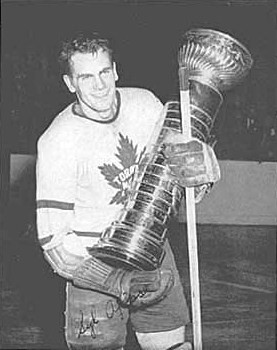
- Ken Randall, 1917–1919
- Frank Heffernan, 1919–1920
- Reg Noble, 1920–1922
- Jack Adams, 1922–1924
- John Ross Roach, 1924–1925
- Babe Dye, 1925–1926
- Bert Corbeau, 1926–1927
- Hap Day, 1927–1937
- Charlie Conacher, 1937–1938
- Red Horner, 1938–1940
- Syl Apps, 1940–1943
- Bob Davidson, 1943–1945
- Syl Apps, 1945–1948
- Ted Kennedy, 1948–1955
- Sid Smith, 1955–1956
- Jimmy Thomson, 1956–1957
- Ted Kennedy, 1957
- George Armstrong, 1958–1969
- Dave Keon, 1969–1975
- Darryl Sittler, 1975–1979, 1980–1982
- Rick Vaive, 1982–1986
- Rob Ramage, 1989–1991
- Wendel Clark, 1991–1994
- Doug Gilmour, 1994–1997
- Mats Sundin, 1997–2008
- Dion Phaneuf, 2010–2016
- John Tavares, 2019–2024
- Auston Matthews, 2024–present
Head Coaches
The Maple Leafs have had 41 head coaches. Dick Carroll was the first coach. Several coaches have served more than once. King Clancy coached three times, while Charles Querrie and Punch Imlach coached twice. Craig Berube is the current head coach, hired on May 17, 2024.
Punch Imlach coached the most regular season games (770) and has the most points (865). Pat Quinn is second with 574 games and 678 points. Sheldon Keefe earned the most points in a single season (115) in 2021–22. Five Maple Leafs coaches are in the Hockey Hall of Fame as players, and four others as builders. Pat Burns is the only Leafs coach to win a Jack Adams Award.
Draft Picks
In the first NHL draft in 1963, the Maple Leafs picked Walt McKechnie. Two Maple Leafs captains, Darryl Sittler (1970) and Wendel Clark (1985), were drafted by the team. The Maple Leafs have picked first overall twice: Clark in 1985 and Auston Matthews in 2016. Other notable draft picks include defenceman Morgan Rielly (2012) and wingers William Nylander (2014) and Mitch Marner (2015). The team's most recent first-round pick was Easton Cowan in 2023.
Announcers
The Toronto Maple Leafs have had four main public address (PA) announcers. Harold (Hap) Watson was the Toronto Arenas' announcer before the team moved to Maple Leaf Gardens.
- Walter (Red) Barber (1931–1961)
- Paul Morris (1961–1999)
- Andy Frost (1999–2016)
- Mike Ross (2016–present)
Team and League Honors
The Maple Leafs have won 13 Stanley Cups. Their first two Cups (1918 and 1922) were won when the Stanley Cup was a competition between different leagues. Their next 11 Cups were won after 1926, when the Cup became the NHL's championship trophy. The Maple Leafs won their last Stanley Cup in 1967. Their 55-season Stanley Cup drought is the longest in the NHL. The Maple Leafs also won the Prince of Wales Trophy twice, in 1947 and 1963, when it was given to the NHL's regular season champion.
Retired Numbers
| No. | Player | Position | Tenure | Date of honour | Date of retirement |
|---|---|---|---|---|---|
| 1 | Turk Broda | G | 1935–1943 1946–1951 |
March 11, 1995 | October 15, 2016 |
| 1 | Johnny Bower | G | 1958–1969 | March 11, 1995 | October 15, 2016 |
| 4 | Hap Day | D | 1924–1937 | October 4, 2006 | October 15, 2016 |
| 4 | Red Kelly | C | 1960–1967 | October 4, 2006 | October 15, 2016 |
| 5 | Bill Barilko | D | 1945–1951 | Not honoured | October 17, 1992 |
| 6 | Ace Bailey | RW | 1926–1933 | Not honoured | February 14, 1934 |
| 7 | King Clancy | D | 1930–1937 | November 21, 1995 | October 15, 2016 |
| 7 | Tim Horton | D | 1949–1970 | November 21, 1995 | October 15, 2016 |
| 9 | Charlie Conacher | RW | 1929–1938 | February 28, 1998 | October 15, 2016 |
| 9 | Ted Kennedy | C | 1942–1955 1956–1957 |
October 3, 1993 | October 15, 2016 |
| 10 | Syl Apps | C | 1936–1943 1945–1948 |
October 3, 1993 | October 15, 2016 |
| 10 | George Armstrong | RW | 1949–1971 | February 28, 1998 | October 15, 2016 |
| 13 | Mats Sundin | C | 1994–2008 | February 11, 2012 | October 15, 2016 |
| 14 | Dave Keon | C | 1960–1975 | Not honoured | October 15, 2016 |
| 17 | Wendel Clark | LW | 1985–1994 1996–1998 2000 |
November 22, 2008 | October 15, 2016 |
| 21 | Borje Salming | D | 1973–1989 | October 4, 2006 | October 15, 2016 |
| 27 | Frank Mahovlich | LW | 1956–1968 | October 3, 2001 | October 15, 2016 |
| 27 | Darryl Sittler | C | 1970–1982 | February 8, 2003 | October 15, 2016 |
| 93 | Doug Gilmour | C | 1992–1997 2003 |
January 31, 2009 | October 15, 2016 |
| Player elected to the Hockey Hall of Fame |
| Number retired for multiple players |
| Number was not honoured before being retired |
The Maple Leafs have retired the numbers of 19 players, but only 13 numbers are retired because some players used the same number. For a while, the Maple Leafs had a unique system. Players with career-ending injuries had their numbers retired, while "great" players had their numbers "honored." Honored numbers could still be used by other players with special permission.
During this time, only two numbers were fully retired: number 6 for Ace Bailey (retired in 1934) and number 5 for Bill Barilko (retired in 1992). Bailey's number was the first retired in professional sports.
The first players to have their numbers honored were Syl Apps and Ted Kennedy in 1993. Mats Sundin was the last player to have his number honored in 2012. On October 15, 2016, the Maple Leafs changed their policy. They announced that all 16 previously honored numbers would now be retired, along with Dave Keon's number.
Besides retiring numbers, the club also has statues of former Maple Leafs players. These statues, called Legends Row, are on a granite hockey bench outside Scotiabank Arena. They were unveiled in September 2014. As of October 2017, there are statues of 14 players with retired numbers.
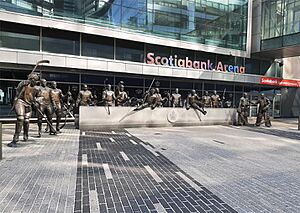
In addition to the 13 numbers retired by the Maple Leafs, number 99 is also retired throughout the NHL. At the 2000 NHL All-Star Game in Toronto, the NHL retired Wayne Gretzky's number 99 from use by all teams.
Hall of Fame
The Toronto Maple Leafs are connected to 78 people in the Hockey Hall of Fame. This includes 64 former players and 13 people who helped build the sport. The Maple Leafs have the most players in the Hockey Hall of Fame of any NHL team. The 13 builders include former Maple Leafs broadcasters, executives, coaches, and other staff. Dave Andreychuk was the latest Maple Leafs player inducted in 2017.
Five Maple Leafs broadcasters have also received the Foster Hewitt Memorial Award from the Hockey Hall of Fame. This award is named after Foster Hewitt, who was the first to receive it in 1984. Other Maple Leafs broadcasters who won the award include Wes McKnight (1986), Bob Cole (2007), Bill Hewitt (2007), and Joe Bowen (2018).
Players
- Jack Adams
- Glenn Anderson
- Dave Andreychuk
- Syl Apps
- George Armstrong
- Ace Bailey
- Tom Barrasso
- Andy Bathgate
- Ed Belfour
- Max Bentley
- Leo Boivin
- Johnny Bower
- Turk Broda
- Harry Cameron
- Gerry Cheevers
- King Clancy
- Sprague Cleghorn
- Charlie Conacher
- Rusty Crawford
- Hap Day
- Gordie Drillon
- Dick Duff
- Babe Dye
- Fernie Flaman
- Ron Francis
- Grant Fuhr
- Mike Gartner
- Doug Gilmour
- George Hainsworth
- Hap Holmes
- Red Horner
- Tim Horton
- Phil Housley
- Syd Howe
- Busher Jackson
- Red Kelly
- Ted Kennedy
- Dave Keon
- Brian Leetch
- Eric Lindros
- Harry Lumley
- Frank Mahovlich
- Lanny McDonald
- Alexander Mogilny
- Dickie Moore
- Larry Murphy
- Joe Nieuwendyk
- Reg Noble
- Bert Olmstead
- Bernie Parent
- Pierre Pilote
- Jacques Plante
- Babe Pratt
- Joe Primeau
- Marcel Pronovost
- Bob Pulford
- Borje Salming
- Terry Sawchuk
- Sweeney Schriner
- Darryl Sittler
- Allan Stanley
- Mats Sundin
- Joe Thornton
- Harry Watson
Builders
- Harold Ballard
- William A. Hewitt
- Conn Smythe
- Jack Bickell
- Punch Imlach
- Pat Burns
- Dick Irvin
- Cliff Fletcher
- Roger Neilson
- Jim Gregory
- Pat Quinn
- Foster Hewitt
- Frank J. Selke
Franchise Career Leaders
These are the top players in regular season points, goals, assists, points per game, games played, and goaltending wins as of the end of the 2024–25 season.
- * – current Maple Leafs player
|
|
|
|
|
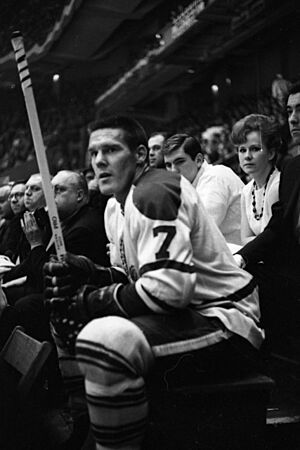
| Player | Seasons | GP | TOI | W | L | T | OT | GA | GAA | SA | SV% | SO |
|---|---|---|---|---|---|---|---|---|---|---|---|---|
| Turk Broda | 1935–1943 1946–1951 |
629 | 38,182 | 304 | 222 | 102 | — | 1,608 | 2.53 | — | — | 61 |
| Johnny Bower | 1958–1969 | 475 | 27,369 | 219 | 157 | 79 | — | 1,139 | 2.50 | 14,607 | .922 | 32 |
| Felix Potvin | 1991–1999 | 369 | 21,461 | 160 | 149 | 49 | — | 1,026 | 2.87 | 11,133 | .908 | 12 |
| Frederik Andersen | 2016–2021 | 268 | 15,625 | 149 | 74 | — | 36 | 726 | 2.79 | 8466 | .914 | 13 |
| Curtis Joseph | 1998–2002 | 270 | 15,808 | 138 | 97 | 27 | 1 | 656 | 2.49 | 7,257 | .910 | 17 |
| Mike Palmateer | 1976–1984 | 296 | 16,828 | 129 | 112 | 41 | — | 964 | 3.44 | 8,886 | .892 | 15 |
| Harry Lumley | 1952–1956 | 267 | 16,003 | 103 | 106 | 58 | — | 581 | 2.18 | 1,696 | .907 | 34 |
| Lorne Chabot | 1928–1933 | 214 | 13,077 | 102 | 78 | 31 | — | 470 | 2.16 | — | — | 31 |
| John Ross Roach | 1921–1928 | 222 | 13,645 | 98 | 107 | 17 | — | 639 | 2.81 | — | — | 13 |
| Ed Belfour | 2002–2006 | 170 | 10,079 | 93 | 61 | 11 | 4 | 422 | 2.51 | 4,775 | .912 | 17 |
More Information
- List of Toronto Maple Leafs players
- List of Toronto Maple Leafs general managers
- Toronto Maple Leafs in popular culture
See also
 In Spanish: Toronto Maple Leafs para niños
In Spanish: Toronto Maple Leafs para niños


